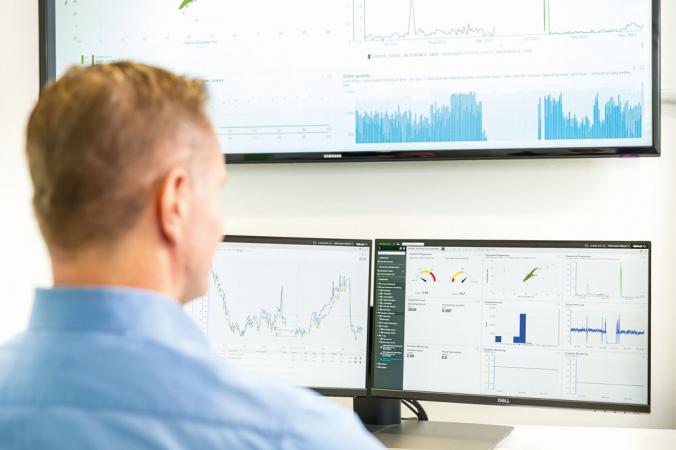Towards Better Asset Performance Modelling
Connecting IT with Operational and Engineering Technology will bring real benefits to Asset Performance Modelling.
In part 1 , released in Maintworld 3/2016, we reviewed how today’s engineering technology makes it possible to bring all required information together helping to track, access, and share with others collaborating on the project. Let’s now have a look how we can get all the benefits of this huge mass of information.
Making the Leap to Asset Performance Modelling
Taking the convergence of IT, OT, and ET one step further, it is now possible to enable real-time asset performance modelling, which ensures that assets are safe, reliable, and efficient over their operating life. For example, Bentley’s asset performance management software enables companies to develop both operational and asset strategies for improving reliability and maintaining asset performance and predictable production.
Using a common data environment (CDE), companies can collect, consolidate, and analyse data and turn it into actionable intelligence. The software also helps ensure regulatory compliance and is aligned with asset management standards, including PAS 55 and ISO 55001. At the same time, it applies leading information modelling and information management technologies to asset operations and maintenance, and when combined with information delivered at handover from projects, provides a complete lifecycle information management solution for owner-operators. This enables owner-operators to optimize processes for the day-to-day running of assets, balancing capital and operational costs and maximizing production capability.
Many companies are already on their way to using these solutions, thanks to the widespread adoption of condition monitoring technologies. As shown in Figure 3, monitoring assets requires the integration of IT and OT systems, as well as big data analytics to discern patterns in data and automate or recommend optimal responses to them.
To move to asset performance modelling, 3D digital engineering models across all disciplines are integrated with the IT and OT systems used for asset performance monitoring (see Figure 3). As the operating baseline for infrastructure assets, digital engineering models bring together schematics; engineering analyses; network models; 3D models; functional components, catalogues, and specifications, as shown in Figure 3.
It is helpful to think of digital engineering information as the digital DNA for infrastructure assets – down to every nut, bolt and screw. Just as doctors can analyse human DNA to anticipate health issues and personalize healthcare for better health outcomes, companies can harness the digital DNA of their assets to personalize asset maintenance for better TOTEX, maximized uptime and more.
For example, companies can manage the performance of their assets far more effectively when they have digital engineering models that intelligently bring together all infrastructure data. When IT and OT systems connect with this ET data, teams can view the asset performance history, see all failure alerts, geo-coordinate to the exact positioning within the infrastructure asset, and drill down into the 3D digital engineering model to determine the cause of the alarm. Then they can refer to the manufacturer’s degradation data, access maintenance and repair data information, and take corrective action – all in seconds.
Harnessing the Power of Continuous Surveying
Having an accurate frame of reference – for example, capturing precisely located photographs and videos and comparing these over time – allows companies to bring together OT, IT, and ET to support asset performance modelling. New, photogrammetric surveying methods allow systems to keep these frames of reference up to date. For example, Bentley’s ContextCapture software is being used to turn digital photography from UAVs and close-up ground shots into accurate as-operated 3D models of infrastructure assets.
Rather than producing a point cloud, the software generates a highly accurate 3D reality mesh that can be brought directly into a 3D engineering environment, and geo-coordinated for precise real-world location, to design in context or compare the digital engineering model with the reality mesh – highlighting differences between the digital design and the actual conditions.
The 3D reality mesh can provide the digital frame of reference aligning all IT, OT, and ET data with the real world. Specific components of the reality mesh can be hyperlinked to relevant documents and schematics, historical performance data, and real-time asset monitoring dashboards. When events occur or alerts are triggered, users can navigate their assets through the 3D mesh and then drill down to related maintenance and repair manuals and more (see Figure 4). The entire experience is immersive, highly accurate, and based on the latest data.
Engineering in Context
These same technologies also allow designers to engineer – and reengineer – in context. For example, when making the decision to repair, replace or remove, rather than starting from scratch or using an existing design model, the engineer or designer can use the continuously surveyed model of the plant or asset as the accurate, 3D representation for the decision. They can walk through the model virtually and explore the options for adding or replacing with new equipment right in the context of the 3D reality mesh.
Once the engineering is approved and construction or replacement begins, the same continuous surveying technique can continuously generate a new 3D reality mesh to track progress and finally create the new point of reference for IT, OT, and ET. Everyone involved can instantly see conditions change as construction progresses – and once work is complete, owner-operators can continuously monitor and model assets to assess conditions, drill down into alerts and issues, take informed action, and optimize asset performance.
Seamless Integration of Processes and Information
We are at an incredibly exciting convergence in the world of asset management. The ability to work in a comprehensive modelling environment, leveraging ContextCapture and 3D reality mesh technologies, and connecting with the Industrial Internet of Things through asset management and predictive analytics software, companies can converge their information technology, operational technology and engineering technology – and seamlessly integrate processes and information flows between them.
The next generation of engineers – digital natives – will no doubt find ways to exploit this convergence in unprecedented ways. We can realize immediate benefits today, by using these technologies to make more informed decisions regarding when to repair, retire, or replace assets so that they are safer, more reliable, and maximally efficient over their operating life.













